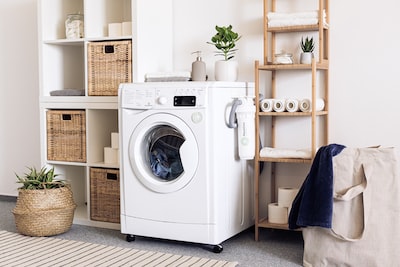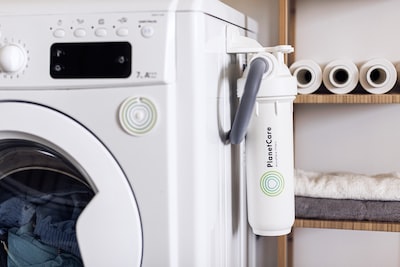Are you tired of handwashing your clothes or still struggling with using a washing machine? Don’t worry, we’ve got you covered. In this beginner’s guide, we will take you through all the steps involved in using a washing machine. From understanding your machine to selecting the right settings, adding detergent and laundry products, loading and starting the machine, and maintaining it for a long-lasting life. We will also provide tips on how to sort your laundry effectively based on colour and material, as well as how to read clothing labels for laundry instructions. Lastly, we’ll answer some frequently asked questions about washing machines usage. With this guide in hand, you’ll be able to take care of your laundry like a pro!
Understanding Your Washing Machine

To effectively use your washing machine and optimize energy use, it’s important to understand its functions and features. Take the time to familiarize yourself with the controls and settings, so you can make the most of each wash. Additionally, knowing the capacity and load size of your machine will help you maximize energy and water usage. Familiarize yourself with the different cycles and options available for various types of laundry. Finally, always refer to the machine manual for specific instructions and troubleshooting tips.
Reading Clothing Labels for Laundry Instructions
When it comes to properly washing your clothes, paying attention to the care labels is essential. These labels provide important instructions for washing your garments in the safest and most effective way. Look for symbols that indicate the recommended washing cycle and water temperature, as they can guide you in selecting the right settings on your washing machine. Additionally, be sure to follow any special instructions for delicate items or fabrics, and take note of any restrictions or precautions mentioned on the labels. Reading clothing labels carefully will help ensure the longevity of your clothes and prevent any damage during the washing process. Make sure to choose the right washing cycle for each garment, as this will ensure that they are cleaned thoroughly and without any damage.
Sorting Your Laundry Effectively
Sorting by Colour
When it comes to sorting your laundry, one important aspect is sorting by color. By separating your laundry into whites, lights, and darks, you can prevent color transfer and staining. Additionally, grouping similar colors together helps maintain brightness and prevents fading. For heavily stained or soiled items, it’s best to treat them separately. To further prevent color bleeding, consider using color-catching sheets. By following these simple steps, you can ensure that your laundry stays vibrant and fresh.
Sorting by Material
When using a washing machine, it’s important to sort your laundry by material. Separate your laundry into categories such as cotton, synthetics, and delicates. This helps prevent damage to delicate fabrics and prevents lint transfer between different materials. For delicate items, consider using a gentle cycle and always check the garment labels for specific washing instructions. By sorting your laundry by material, you can ensure that each item is washed in the most appropriate way, leading to cleaner and well-maintained clothes. Additionally, it is crucial to separate heavier items like towels and blankets from lighter items such as lingerie and delicates. This prevents the heavier items from causing damage to the lighter fabrics during the washing process. Furthermore, lint-shedding garments and lint-attracting ones like microfiber and corduroy should also be separated to avoid lint transfer. By sorting your laundry not only by material but also by weight and fabric type, you can ensure optimal washing results.
Selecting the Right Settings on Your Washer
When using your washing machine, it’s essential to select the right settings to ensure optimal cleaning and fabric care. Start by adjusting the water temperature according to the garment’s instructions. Choose the appropriate wash cycle based on the level of soil and fabric type. For lightly soiled items, quick wash cycles can be a time-saving option. Take advantage of special features like pre-soak or extra rinse when needed. Additionally, consider selecting eco-friendly settings to minimize energy and water usage. Every cycle is comprised of two distinct velocities: The wash velocity, in which garments are tumbled with water, and the spin velocity, in which items are spun to eliminate water. Although these velocities differ from one cycle to another, it is generally understood that higher agitation results in greater cleaning effectiveness, while lower agitation guarantees better fabric preservation.. By following these simple steps, you can achieve clean and fresh laundry efficiently.
Choosing the Right Temperature
When it comes to choosing the right temperature for your laundry, there are a few key factors to consider. Firstly, for delicate or brightly colored items, it’s best to select a cold water wash. This helps to prevent any potential damage or color fading. For everyday laundry loads, warm water is typically the most effective in removing dirt and stains. However, for heavily soiled items or bedding, using hot water can provide a more thorough clean. The gentlest way to wash your clothes is with cold water, which uses less energy and saves you money. Always remember to adjust the water temperature according to the fabric’s care label. Lastly, don’t be afraid to experiment with different water temperatures to find the best results for your laundry.
Picking the Appropriate Wash Cycle
When it comes to picking the appropriate wash cycle for your laundry, there are a few factors to consider. For most laundry loads, the normal or regular cycle will be sufficient. However, if you have delicate clothes or lingerie, it’s best to opt for a gentle or delicate cycle. To minimize wrinkles in synthetic or mixed fabrics, the permanent press cycle is recommended. For heavily soiled items or linens, the heavy-duty cycle will provide a thorough clean. Don’t be afraid to experiment with different wash cycles to find the best fit for your laundry needs.
Adding Detergent and Other Laundry Products

To ensure optimal cleaning, it’s important to follow the recommended dosage of laundry detergent. Place the detergent box either in the designated dispenser or directly into the drum of your washing machine. For added freshness, consider using fabric softener or scent boosters. If you’re dealing with stubborn stains, adding stain removers or pre-treatments can be helpful. However, be cautious not to overload the machine with too many products as it can affect washing performance.
Detergent Placement in Front Load vs Top Load Washers
When it comes to detergent placement, there are some key differences between front load and top load washers. In front load washers, the detergent is typically placed in the designated drawer or dispenser, specifically in the largest section of the drawer on the left-hand side. On the other hand, for top load washers, the detergent should be added directly into the drum before loading the laundry. It’s important to follow the guidelines in your machine manual for specific instructions. Regardless of the type of washer you have, avoid placing detergent on top of clothes as it may not dissolve properly. Additionally, be sure to use the appropriate amount of detergent based on the load size and dirt level.
Loading and Starting the Washing Machine
To ensure optimal results, evenly distribute your laundry inside the drum. Take care to follow the instructions on the care labels when sorting your garments. Select the appropriate washing cycle based on the fabric type and choose the right water temperature for your load. To ensure effective cleaning, add the recommended amount of detergent to the dispenser. A general guideline is to maintain a gap of approximately the width of your hand between the drum’s top and your load. It is also advisable to arrange them loosely within. Refer to your washer manual for accurate information on the maximum capacity. By following these simple steps, you can start the washing machine and begin the cleaning process efficiently.
Maintaining Your Washing Machine
To keep your washing machine running smoothly and efficiently, regular maintenance is essential. Clean the machine regularly to prevent build-up and odors. Utilize a washing machine cleaner to remove residue and maintain optimal performance during the spin cycle. Remember to check and clean the filter to ensure proper drainage. After each use, leave the door open to allow the drum to dry thoroughly. Additionally, avoid overloading the machine as it can lead to damage. By following these simple steps, you can extend the life of your washing machine.
Common Mistakes to Avoid When Using a Washing Machine
When using a washing machine, there are common mistakes that should be avoided to ensure optimal results. One mistake is overloading the machine, which can affect the cleaning efficiency. Using too much detergent is another error to steer clear of, as it can leave residue on clothes. Mixing different colors or fabrics that require different washing cycles should also be avoided. Additionally, ignoring unusual noises or vibrations and using fabric softener on certain fabrics, like microfiber, can lead to issues. By avoiding these mistakes, you can make the most out of your washing machine and achieve clean, fresh-smelling wet clothes.
FAQs about Washing Machine Usage
When it comes to washing machines, there are a few common questions that arise. One of them is how often you should clean your washing machine. It is recommended to clean your washing machine every 2 months to maintain its performance. Another question is where a washing machine should be located in the house. Ideally, it should be placed on a sturdy, level surface away from direct sunlight. Lastly, people often wonder about the water and energy consumption levels of washing machines. It is advised to look for washing machines with high water and energy efficiency ratings.
How often should you clean your washing machine?
It is recommended to clean your washing machine every two months to maintain its performance and prevent buildup of dirt and residue. Regular cleaning helps in prolonging the lifespan of your machine and ensuring clean and fresh laundry.
Where should a washing machine be located in the house?
Where should a washing machine be located in the house? The ideal location for a washing machine is on the ground floor near a water source and drainage system. It is important to have enough space around the machine for easy loading and unloading of laundry. Avoid placing it in areas susceptible to extreme temperatures or moisture. While there is no definite rule that specifies where a washing machine should be located, it is generally recommended to consider safety precautions.
What are the Water and Energy Consumption Levels of Washing Machines?
What are the Water and Energy Consumption Levels of Washing Machines? Washing machines vary in their water and energy consumption levels depending on factors such as size, model, and features. Front-loading machines tend to use less water and energy compared to top-loading machines, resulting in high water efficiency. Energy-efficient models with higher ratings consume less energy during operation. It’s important to consider these factors when choosing a washing machine to minimize water and energy usage.
Conclusion
In conclusion, using a washing machine effectively requires understanding its functionalities and following proper laundry instructions. Sorting your laundry by color and material helps prevent damage and maintain the quality of your clothes. Selecting the right temperature and wash cycle ensures that your clothes are cleaned thoroughly. Adding detergent and other laundry products correctly is essential for effective cleaning. Loading and starting the washing machine properly guarantees that your clothes are washed evenly. Regular maintenance of your washing machine prolongs its lifespan and efficiency. Lastly, avoid common mistakes such as overloading the machine or using excessive detergent. By following these tips and guidelines, you can make the most out of your washing machine and keep your clothes clean and fresh.



